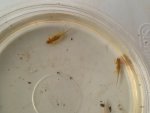otolith
Member
- Joined
- Dec 16, 2009
- Messages
- 484
- Reaction score
- 24
- Points
- 18
- Country
- United States
I posted in the species forums rather than the illness help as this is more of an observation than a call for help. I am wondering if anyone else has had the same experience when raising Lissotriton (or any other species).
I've observed in the two years I have raised Lissotriton larvae that a small have suffered from serious edema as they develop. The onset initially followed rear leg development and slowly increased in severity as the larvae grew. Last year it effected about 1% of larvae.
This year I experimented with two different methods of raising larvae; a 28L plastic tub in a basement kept at 58-62F and a 15 gallon tank "pond" set up with live plants left outdoors. The outdoor tank experienced a wider range of temperature but did not get above 70F during the day or below 55F at night. Out of 30 Lissotriton larvae left outdoors nearly half developed bloat following rear leg development. I have a similar outdoor set up with T. dobrogicus larvae and have experienced no losses or bloat. In the basement set up only 2 of 60 larvae had any bloat issues.
My take away from this is that Lissotriton v. ampelensis seem especially prone to stress issues during significant points in larval development and that stable temperature is essential to success. While this can be said for all larvae, some species I've raised (T. dobrogicus, M. a. apuanus, T. karelinii) show much greater tolerance for temperature change. I have only experienced bloat issues with Lissotriton. Have any other keepers come to similar conclusions or have any additional insight? I would love to hear others' experiences.
These photographs are of the worst effected animals right before euthanasia.
I've observed in the two years I have raised Lissotriton larvae that a small have suffered from serious edema as they develop. The onset initially followed rear leg development and slowly increased in severity as the larvae grew. Last year it effected about 1% of larvae.
This year I experimented with two different methods of raising larvae; a 28L plastic tub in a basement kept at 58-62F and a 15 gallon tank "pond" set up with live plants left outdoors. The outdoor tank experienced a wider range of temperature but did not get above 70F during the day or below 55F at night. Out of 30 Lissotriton larvae left outdoors nearly half developed bloat following rear leg development. I have a similar outdoor set up with T. dobrogicus larvae and have experienced no losses or bloat. In the basement set up only 2 of 60 larvae had any bloat issues.
My take away from this is that Lissotriton v. ampelensis seem especially prone to stress issues during significant points in larval development and that stable temperature is essential to success. While this can be said for all larvae, some species I've raised (T. dobrogicus, M. a. apuanus, T. karelinii) show much greater tolerance for temperature change. I have only experienced bloat issues with Lissotriton. Have any other keepers come to similar conclusions or have any additional insight? I would love to hear others' experiences.
These photographs are of the worst effected animals right before euthanasia.


